
FINCA Project: Flora Introduced and Naturalized in Central America
Central America has a large gradient of climate patterns and habitats and a remarkable biodiversity. Currently, one of the most pressing conservation issues across this region is the expansion of invasive alien species. In this project, we are compiling an inventory of the alien (naturalized and invasive) plants species of Central America. We are using this inventory to describe the structure, composition, and diversity of alien plants in this region and to identify regional patterns of naturalization and invasion.
Central America has a large gradient of climate patterns and habitats and a remarkable biodiversity. Currently, one of the most pressing conservation issues across this region is the expansion of invasive alien species. In this project, we are compiling an inventory of the alien (naturalized and invasive) plants species of Central America. We are using this inventory to describe the structure, composition, and diversity of alien plants in this region and to identify regional patterns of naturalization and invasion.
- Collaborator: Eduardo Chacón-Madrigal
- Project Website: https://finca.collaboration.uconn.edu/
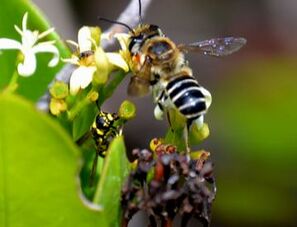
Caribbean Pollination Networks
Worldwide, there is a widespread concern about the loss of pollinators. In this project we are using a plant-pollinator network approach to: (1) describe the diversity, structure, and stability of the local assembly of insect pollinators and the plants pollinated by them within native forests in the Caribbean, (2) assess the role of the non-native Apis mellifera as a novel pollinator on Caribbean islands, and (3) evaluate the potential effects of Apis mellifera on the composition and function of native communities of plants and insect pollinators.
Worldwide, there is a widespread concern about the loss of pollinators. In this project we are using a plant-pollinator network approach to: (1) describe the diversity, structure, and stability of the local assembly of insect pollinators and the plants pollinated by them within native forests in the Caribbean, (2) assess the role of the non-native Apis mellifera as a novel pollinator on Caribbean islands, and (3) evaluate the potential effects of Apis mellifera on the composition and function of native communities of plants and insect pollinators.
- Collaborators: Jim Ackerman, J. Fumero-Caban, Trugrul Giray, & Mike Willig.
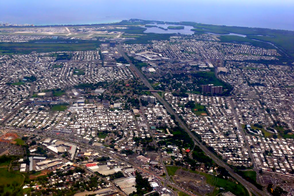
Urban Ecology: In this project, our goal is to identify and evaluate different drivers of urban biodiversity and ecosystem services in urban green spaces at the Rio Piedras Watershed and the San Juan Metropolitan Area in Puerto Rico.
- 1. Assessment of native and non-native plant species occurring in residential yards in San Juan.
- 2. Response of urban forests to hurricane disturbances.
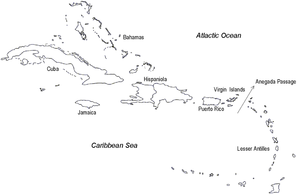
Ecology and Biogeography of Caribbean Invasions
In this project we are using data on native, naturalized, and invasive plant species collected on islands across the West Indies including the Bahamas, Greater and Lesser Antilles, Trinidad and Tobago and the Netherlands Antilles to: (1) describe the invasive flora of islands across the West Indies, (2) identify patterns of invasion, and (3) identify and evaluate ecological, geographical, historical, and socioeconomic factors that best correlate with the invasive species diversity on these islands (Collaborators: James Ackerman and Raymond Tremblay).
In this project we are using data on native, naturalized, and invasive plant species collected on islands across the West Indies including the Bahamas, Greater and Lesser Antilles, Trinidad and Tobago and the Netherlands Antilles to: (1) describe the invasive flora of islands across the West Indies, (2) identify patterns of invasion, and (3) identify and evaluate ecological, geographical, historical, and socioeconomic factors that best correlate with the invasive species diversity on these islands (Collaborators: James Ackerman and Raymond Tremblay).
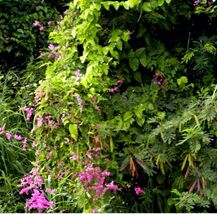
Caribbean Invasive Plants & CABI-Compendium
The goal of this project is to identify, classify, and analyze alien plant species
behaving as invaders on islands across the Caribbean region. For each target
species, we perform a full revision on taxonomy, worldwide distribution, habitat
preferences, invasiveness, and ecological, economical, and social impacts as
well as management recommendations. Once completed and edited, each
species revision is published online as a "datasheet" in the CABI Invasive
Species Compendium.
*For more details about this project click here --> CISP
*To access the Invasive Species Compendium click here--> www.cabi.org/isc
The goal of this project is to identify, classify, and analyze alien plant species
behaving as invaders on islands across the Caribbean region. For each target
species, we perform a full revision on taxonomy, worldwide distribution, habitat
preferences, invasiveness, and ecological, economical, and social impacts as
well as management recommendations. Once completed and edited, each
species revision is published online as a "datasheet" in the CABI Invasive
Species Compendium.
*For more details about this project click here --> CISP
*To access the Invasive Species Compendium click here--> www.cabi.org/isc
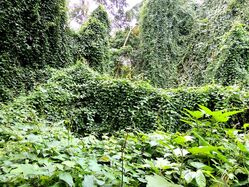
Naturalization and invasions of alien plants in Puerto Rico and Virgin Is.
A fundamental goal in invasion ecology is to identify and understand the factors explaining why some alien species become invasive when others fail. In this project, we gathered data on taxonomy, invasive status, invasion history, geographic distribution, and biological and ecological traits of >1,000 alien plant species occurring in Puerto Rico and the Virgin Islands. Currently, we are using these data to evaluate the relative importance of habitat and species attributes in determining the likelihood of alien plants to become naturalized and subsequently invasive on these islands (Collaborator: Pedro Acevedo).
A fundamental goal in invasion ecology is to identify and understand the factors explaining why some alien species become invasive when others fail. In this project, we gathered data on taxonomy, invasive status, invasion history, geographic distribution, and biological and ecological traits of >1,000 alien plant species occurring in Puerto Rico and the Virgin Islands. Currently, we are using these data to evaluate the relative importance of habitat and species attributes in determining the likelihood of alien plants to become naturalized and subsequently invasive on these islands (Collaborator: Pedro Acevedo).
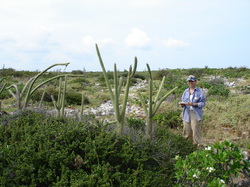
Harrisia Project
The main goal of this project is the identification and evaluation of vulnerability factors affecting the threatened cactus species Harrisia portoricensis on Mona Island, Puerto Rico. This project involved an exhaustive analysis of the pollination biology, breeding systems, and reproductive phenology of this cactus species. We are also investigating the spatial patterns of biotic and abiotic factors affecting the distribution and abundance of Harrisia and the effects of invasive grasses on its demographic parameters. We are using long-term demographic data collecting since 2007 and applying population matrix models and integral models to evaluate the conservation status and the population dynamics of this endangered species (Collaborator: E. Meléndez-Ackerman).
The main goal of this project is the identification and evaluation of vulnerability factors affecting the threatened cactus species Harrisia portoricensis on Mona Island, Puerto Rico. This project involved an exhaustive analysis of the pollination biology, breeding systems, and reproductive phenology of this cactus species. We are also investigating the spatial patterns of biotic and abiotic factors affecting the distribution and abundance of Harrisia and the effects of invasive grasses on its demographic parameters. We are using long-term demographic data collecting since 2007 and applying population matrix models and integral models to evaluate the conservation status and the population dynamics of this endangered species (Collaborator: E. Meléndez-Ackerman).
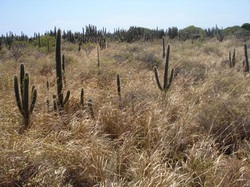
Grass invasions on semiarid ecosystems
The impact of invasive species around the world is among the primary threats to the conservation and management of rare and endangered species. In this project, we evaluate the impact of the African grass Megathyrsus maximus on the composition and abundance of native plants within semiarid ecosystems in the Caribbean. For this purpose, we have develop a large-scale experiment with plots with different grass management treatments (i.e., complete and partial grass removal). We are using these results to identify the most appropriate management and conservation strategies for these invaded plant communities (Collaborator: E. Meléndez-Ackerman).
The impact of invasive species around the world is among the primary threats to the conservation and management of rare and endangered species. In this project, we evaluate the impact of the African grass Megathyrsus maximus on the composition and abundance of native plants within semiarid ecosystems in the Caribbean. For this purpose, we have develop a large-scale experiment with plots with different grass management treatments (i.e., complete and partial grass removal). We are using these results to identify the most appropriate management and conservation strategies for these invaded plant communities (Collaborator: E. Meléndez-Ackerman).
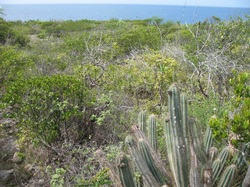
Mona Project
The dry forest of Mona Island represents an excellent opportunity to study the dynamics of vegetation structure under the interplay of large-scale disturbances (i.e., hurricanes) vs small-scale disturbances (i.e., herbivory by feral goats). Mona Island is located within the Caribbean hurricane-prone area and early in the 16th century feral goats were introduced on this island. For this project, vegetation within fenced and unfenced plots has been monitored annually since 1997. Currently, we are using these long-term vegetation data to evaluate the interplay between goat herbivory and hurricane effects on community structural dynamics (with E. Meléndez-Ackerman and CATEC).
The dry forest of Mona Island represents an excellent opportunity to study the dynamics of vegetation structure under the interplay of large-scale disturbances (i.e., hurricanes) vs small-scale disturbances (i.e., herbivory by feral goats). Mona Island is located within the Caribbean hurricane-prone area and early in the 16th century feral goats were introduced on this island. For this project, vegetation within fenced and unfenced plots has been monitored annually since 1997. Currently, we are using these long-term vegetation data to evaluate the interplay between goat herbivory and hurricane effects on community structural dynamics (with E. Meléndez-Ackerman and CATEC).
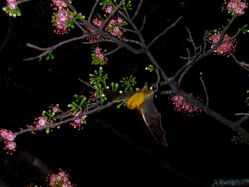
Phenology and reproductive biology of tropical trees
In this project, we evaluated the reproductive biology and phenological patterns of Ceiba pentandra populations in the tropical dry forests (i.e., Guanacaste) and wet forests (i.e., Osa Peninsula) of the Pacific coast of Costa Rica. This project involved a multiyear monitoring of the reproductive phenology of Ceiba trees as well as controlled-pollination experiments and flower-visitor observations (with J.A. Lobo and M. Quesada).
In this project, we evaluated the reproductive biology and phenological patterns of Ceiba pentandra populations in the tropical dry forests (i.e., Guanacaste) and wet forests (i.e., Osa Peninsula) of the Pacific coast of Costa Rica. This project involved a multiyear monitoring of the reproductive phenology of Ceiba trees as well as controlled-pollination experiments and flower-visitor observations (with J.A. Lobo and M. Quesada).
